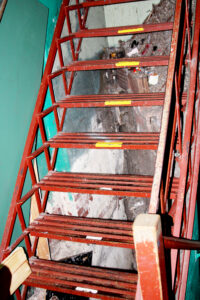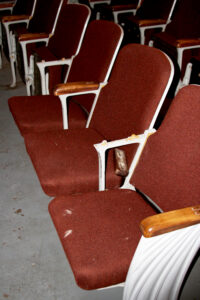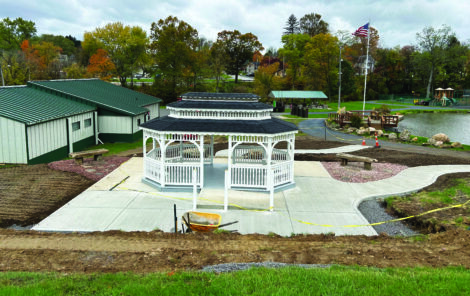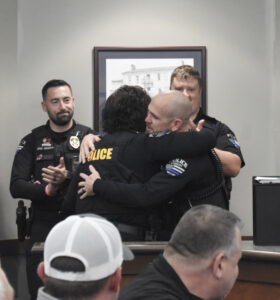Historical reflection on the Salem Community Theatre

The Salem Community Theater has been a beloved landmark on State Street for 103 years and Salem’s hub for the theatrical arts; however, the historic venue is in need of repairs and updates which will preserve its historic character while modernizing it for a new generation of performers and patrons. Fundraising Chair Kathleen Lassiter said that while the backstage stairs to the balcony were structurally sound, that they were never enclosed from the theatre’s past as a movie theater and present a risk of personal items or props being dropped with no way to retrieve them. (Photo by Morgan Ahart)
- The Salem Community Theater has been a beloved landmark on State Street for 103 years and Salem’s hub for the theatrical arts; however, the historic venue is in need of repairs and updates which will preserve its historic character while modernizing it for a new generation of performers and patrons. Fundraising Chair Kathleen Lassiter said that while the backstage stairs to the balcony were structurally sound, that they were never enclosed from the theatre’s past as a movie theater and present a risk of personal items or props being dropped with no way to retrieve them. (Photo by Morgan Ahart)
- The Salem Community Theater has been a beloved landmark on State Street for 103 years and Salem’s hub for the theatrical arts; however, the historic venue is in need of repairs and updates which will preserve its historic character while modernizing it for a new generation of performers and patrons. Fundraising Chair Kathleen Lassiter said that the biggest challenging facing the theater was replacing its 270 seats which were installed used in 1981 when the theater was first renovated and some of which are experiencing stability issues. (Photo by Morgan Ahart)
The building which is now the Salem Community Theatre began its long life on East State Street on Thanksgiving Day in 1922 as the State Theatre, with an evening showing of “Smilin’ Through” starring Norma Talmadge. At that time the theater seated 750, with seating available on both the first floor and balcony, and was owned by Virgil Rakestraw, who also owned the then Grand Opera House, which would be renamed the Grand Theatre the following year in 1923, and the Royal Theatre on Main Street. Rakestraw would continue to operate the theaters for several years, advertising the State Theatre as “the house with the organ, showing only the best photo plays obtainable” in 1927. In 1931 the operation of the State, Royal, and Grand were taken over by Nathaniel “Nat” Walken who managed the State and Washington Theatres in Washington, Pennsylvania for 12 years prior to relocating to Salem.
Walken would oversee operations at the State for the next 33 years until his retirement on May 2, 1964; he also continued to operate the Royal for a year before closing it due to low attendance and the Grand until it closed its doors in 1955. During his time running the State and Grand he would make steady improvements to both, with air conditioning installed at the State as early as 1936, and Cinemascope added in 1952 when it was still rare at local movie theaters. From 1932 to 1934 tickets at the State Theatre cost nine cents for children and 25 to 35 cents for adults, with the 1933-1934 season including major features like Disney’s “Snow White and the Seven Dwarves.” The State and Grand were also the first in Salem to screen landmark films like “Gone with the Wind” (1939) and “Ben Hur” (1959).
During the second World War over 5,000 servicemen are estimated to have been admitted at the State Theatre free of charge while in town, and hundreds of children were given free passes to the theater for marching in Memorial Day parades. During this period Walken, himself a veteran of the Great War, would be presented with the Distinguished Service Emblem by the United States War Finance Committee for personally selling approximately a quarter of a million dollars in war bonds.
On the day of Walken’s retirement, the State was showing “Love with the Proper Stranger” starring Natalie Wood and Steve McQueen, and tickets cost only 75 cents for an adult and 35 cents for children.

The Salem Community Theater has been a beloved landmark on State Street for 103 years and Salem’s hub for the theatrical arts; however, the historic venue is in need of repairs and updates which will preserve its historic character while modernizing it for a new generation of performers and patrons. Fundraising Chair Kathleen Lassiter said that the biggest challenging facing the theater was replacing its 270 seats which were installed used in 1981 when the theater was first renovated and some of which are experiencing stability issues. (Photo by Morgan Ahart)
While the State would be purchased from Rakestraw’s widow Jean by the Salem Community Theatre Inc in 1981, the company itself was founded in 1977 by Charles Williams and Judy Waugh and held their initial performances at locations around the city. The theater’s first director was Cathy Verhoff, who selected “Godspell” as the company’s first performance as a budget and casting friendly option, which was performed in the Salem High School auditorium. The Community Theatre’s inaugural 1977-1978 season also featured performances of “Softy the Snowman” and “Jacques Brel” at the American Legion, “Virgina Wolff” and “the Alchemist’s Book” at the former YWCA on North Lincoln, “The Boyfriend” at the Junior High School, and concluded with Verhoff’s favorite show, “Jesus Christ, Superstar,” at the high school. At that time tickets cost $2.50 for children and $3.50 for adults; however, tickets for Superstar were $5.
While “Jesus Christ, Superstar” proved to be a controversial choice, with picketers outside during performances, it was popular with theatregoers and a major financial success, selling out the 1,000 seat auditorium for its first performance. In 1979 the company offered productions of “A Thousand Clowns,” “Promises, Promises” and “Fiddler on the Roof” while seeking a permanent home for the company.
The initial plan was to purchase the former Grand Theatre and rebuild the auditorium which had been torn down due to its history as the only theater in Salem to have hosted live theater and dimensions more conducive to live productions. The second option seriously considered was a property on English Street; however, both plans failed to earn the support of the Salem Community Foundation to fund necessary renovations. The State Theatre was ultimately purchased for $75,000 to be paid in annual installments of $15,000 at 8% interest and was renovated in stages through a $150,000 grant from the Community Foundation which was paid out in installments of $25,000.
The first things renovated were the theater’s second floor which included rehearsal and teaching spaces, as well as dressing rooms, with classes beginning the day after renovations to the space were completed. The theater’s exterior and stage area, including the seats which were in severe disrepair when the theater was purchased, were completed next as part of an agreement with the Community Foundation for an advance of grant funding so that the Community Theatre could begin staging its live shows. During these early years the theater also continued showing movies.
The Community Theatre’s first production on State Street was held in May of 1981, with a performance of “The Red Dragon,” an original piece co-authored by Verhoff and Greg Smith. In 1982 the theater was named one of the top 10 community theaters in the state and has continued to present a full slate of live theatrical productions annually ever since, cultivating a dedicated community of performers, and crew, and a dedicated audience.
However, 44 years since that major remodel the theater requires updates to ensure its continued operation for Salem’s next generation of dramatists. To that end the theater is launching a capital campaign to fund infrastructure repairs, safety enhancements, and renovations to improve the overall experience for actors, volunteers, and audiences. Those efforts kickoff this afternoon with an open house event from 2 to 4 p.m., featuring guided tours of the theater with photos and memorabilia from its rich history including posters, playbills, and photos from past productions and even from its time as the State Theatr on display, refreshments, and information about how the public can help revitalize the theater.




